
- Best Sellers
- Shop By Color
- New Arrivals
- Black Rubber Straps
- Blue Rubber Straps
- Orange Rubber Straps
- Shop by Material
- Shop by Rolex Model >
- Rolex | Rubber Straps
- Rolex | Leather Straps
- Sea-Dweller
- Explorer II
- Yacht-Master
- Oyster Perpetual
- CUSTOM TUDOR WATCH STRAPS
- CUSTOM PANERAI WATCH STRAPS
- Shop by Lug Size
- 20MM Straps
- Leather Watch Straps
- 21MM Straps
- Rubber Watch Straps
- 22MM Straps
- Nylon Watch Straps

- WATCH ROLLS
- WATCH BOXES
- SPRING BARS

Curved End Rubber Strap for Rolex Yacht-Master Deployant

- In stock, ready to ship
- Inventory on the way
All Everest products ship from our US fulfillment within 24-48 hours of the order being placed. Free USPS priority mail shipping is offered on order over $100. Click HERE for more information on our shipping.
This site is protected by reCAPTCHA and the Google Privacy Policy and Terms of Service apply.
STRAP OVERVIEW
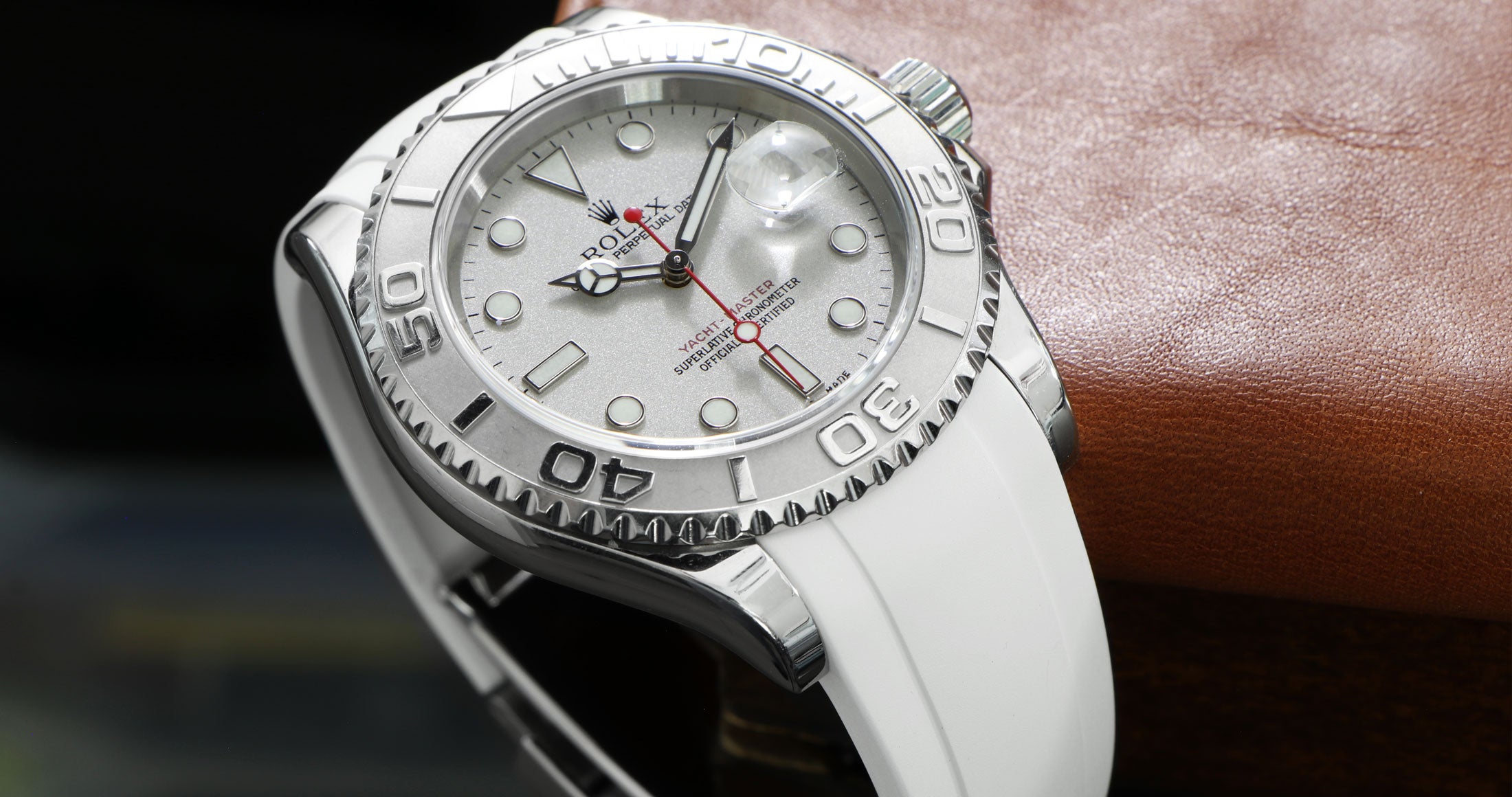
Everest Curved End Rubber straps are intentionally and meticulously designed to create a flawless case connection to your Rolex Yacht-Master. The easy-to-install, curved end rubber strap comes equipped with Rolex grade spring bars. At the connection point, there is a hardened plastic insert. This ensures a strengthened case connection.
Your Rolex Yacht-Master was thoughtfully designed. The strap you put it on should be no different. Everest’s Curved End Rubber Strap hugs the contours of your watch, and more importantly, the contours of your wrist. With a gently tapered silhouette, this strap stays out of the way – but still feels secure. The underside features airflow channels for a breathable, sweatproof experience. No detail was spared when designing this strap; it’s the perfect fit for your Rolex Yacht-Master.

Swiss-made from FKM vulcanized rubber, the Everest Curved End Rubber straps are hypoallergenic, resistant to UV Rays, dust, stains, stretch and tear. The extreme durability of this premier rubber material is only rivaled by its incredible comfort. Everest Curved End Rubber straps are pliable, smooth, and long-lasting.
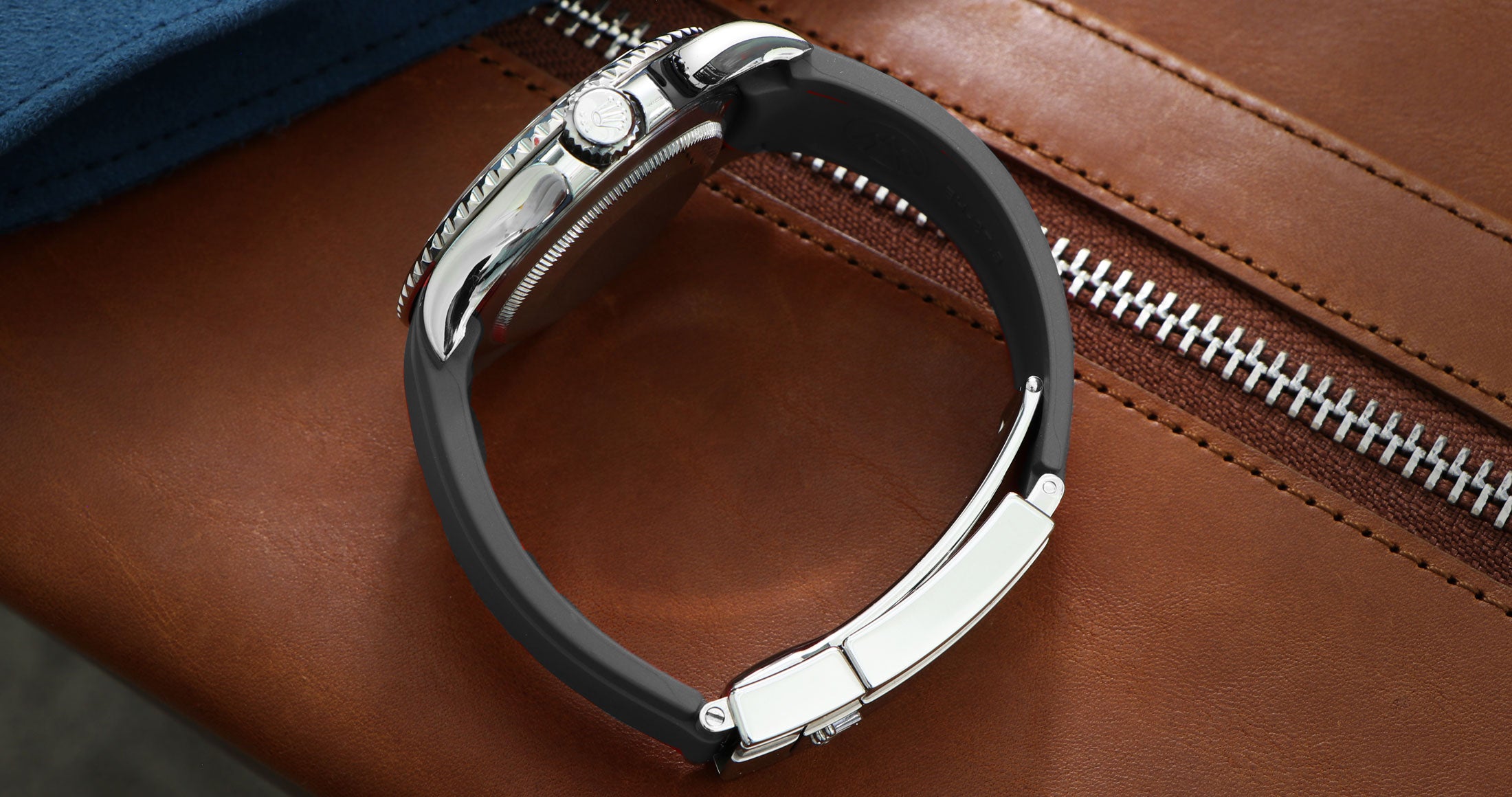
The Everest curved end rubber deployant strap is our most popular product for a reason, it looks amazing on any watch, but especially the Rolex Yacht-Master. It allows your watch to have a more casual and sporty look while integrating your original Rolex clasp. Everest straps are designed to be so comfortable, you may never want to put your Rolex Yacht-Master bracelet back on.
CLICK HERE TO SHOP EVEREST BANDS' INSTAGRAM #EVERESTBANDS
Everest bands.
- Vintage Club
- Epi Leather - Waterproof
- Saffiano - Waterproof
- Croco & Aligator
- Ostrich Leg
- Chevre - French Goat
- Diablo - Italian Leather
- Exotic Skin
- Submariner Green Hulk
- GMT Master II
- GMT Master II Batman
- GMT Master II Pepsi
- Sea-Dweller
- Sky-Dweller
- Yacht Master
- Oyster Perpetual
- Other Rolex Watches
- Submersible
- Royal Oak 39 & 41mm
- ROO 43mm & 42mm "Quick Release"
- ROO 37mm Ladies
- Speedmaster Moonwatch
- Dark Side of the Moon
- Seamaster Diver 300m
- Seamaster Planet Ocean
- Seamaster Aqua Terra
- MoonSwatch X Swatch
- Blackbay 41mm
- Blackbay Bronze 43mm
- Fifty Eight 39mm
- Blackbay GMT
- Other Tudor Watches
- Super Ocean Heritage
- Super Ocean
- Other Breitling Watches
- BR 01, 02, 03, BR X, BR S
- BR V Series
- Other Bell & Ross Watches
- Nautilus (Strap)
- Complication & Calatrava
- Portugieser & Portofino
- Other IWC Watches
- New Santos "Quick Release"
- Santos Dumont
- Santos 100 XL
- Other Cartier Watches
- Apple Watch
- SevenFriday
- Bell and Ross
- AP ROO 42mm
- AP ROO 44mm
- Velcro Style
- Louis Vuitton & Gucci
- Hornback Croco
- SHOP BY WATCH ROLEX Submariner Submariner Green Hulk Daytona GMT Master II GMT Master II Batman GMT Master II Pepsi Datejust Daydate Explorer Sea-Dweller Sky-Dweller Yacht Master Oyster Perpetual Other Rolex Watches PANERAI Luminor Radiomir Submersible AUDEMARS PIGUET ROO 42mm ROO 44mm ROO Diver Royal Oak 39 & 41mm ROO 43mm & 42mm "Quick Release" ROO 37mm Ladies OMEGA Speedmaster Moonwatch Dark Side of the Moon Seamaster Diver 300m Seamaster Planet Ocean Seamaster Aqua Terra MoonSwatch X Swatch TUDOR Blackbay 41mm Blackbay Bronze 43mm Fifty Eight 39mm Blackbay GMT Pelagos Other Tudor Watches TAG HEUER Aquaracer Carrera Formula 1 Autavia Monaco BREITLING Navitimer Super Ocean Heritage Avenger Super Ocean Other Breitling Watches BELL AND ROSS BR 01, 02, 03, BR X, BR S BR V Series Other Bell & Ross Watches PATEK PHILIPPE Nautilus (Strap) Aquanaut Complication & Calatrava IWC Pilot Portugieser & Portofino Other IWC Watches HUBLOT All Series RICHARD MILLE All Series CARTIER New Santos "Quick Release" Santos Dumont Santos 100 XL Other Cartier Watches Vacheron Constantin All Series Other Watches Apple Watch SevenFriday Seiko
Rolex Yacht Master Straps
- $100 - $199
- $200 - $299
- Calf Leather
- Waterproof Leather
- Louis Vuitton
- Bottega Pattern
Welcome to The Rolex Yacht Master Strap Guide.
Here is some of our most popular straps on Yacht Master, so you can see how the different combinations work. You can also ask the custom request, such as : changing stitching style, changing stiching colour, requesting thickness you prefer, even the edge colour.
If you don't find anything you like here, you are welcome to browse on other category. We try to make it easy for you to navigate in our website, so feel free to browse and browse until you find the one you like!
The Rolex Yacht-Master 42 in Yellow Gold ref. 226658
The sleek 42mm yacht-master, now in a gleaming yellow gold case..
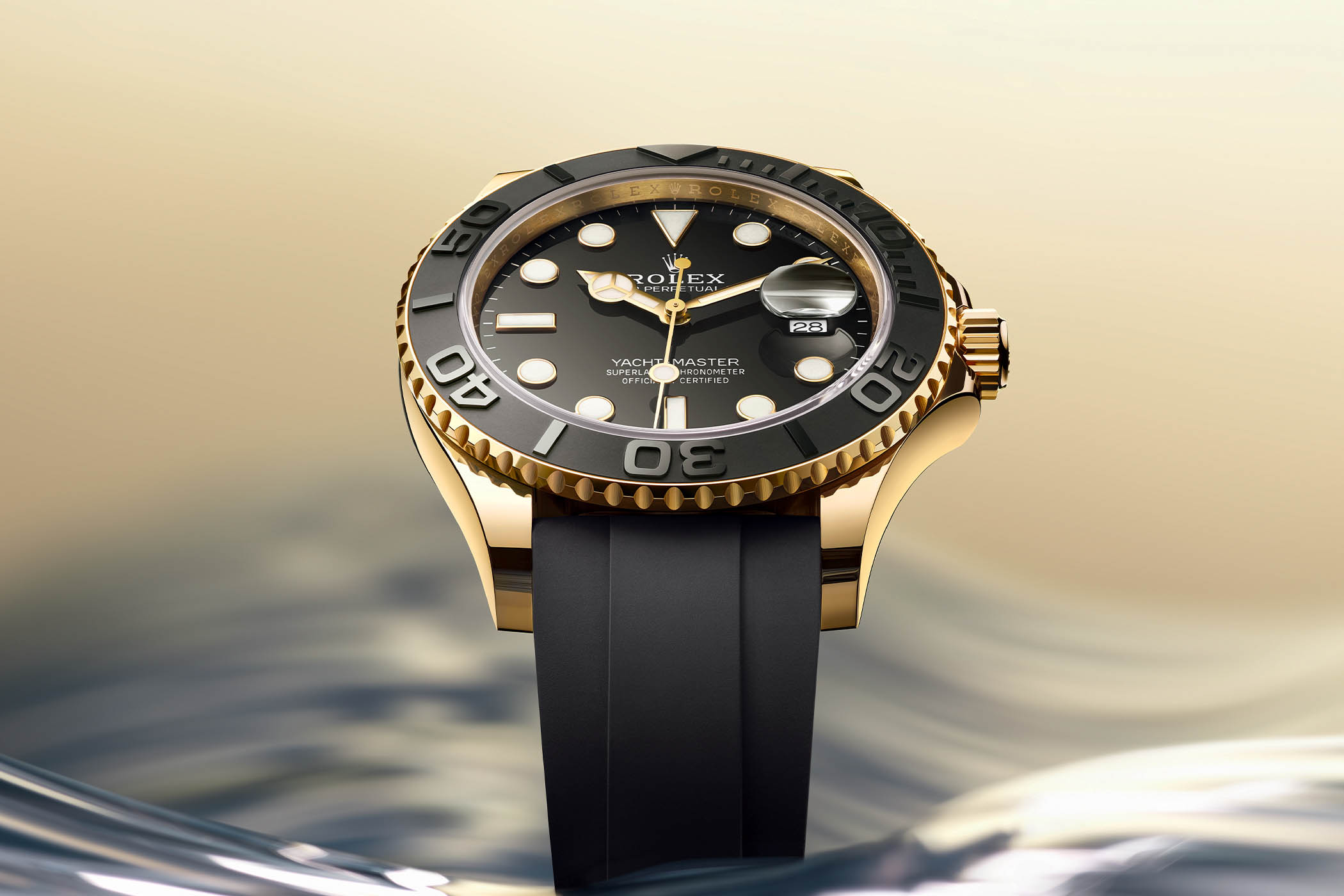
It’s the yearly watch launch season, and all eyes will be focused on Rolex today as it unveils its 2022 novelties. Among these is the new Yacht-Master 42 in yellow gold. Touted as Rolex’s “watch of the open seas”, the Yacht-Master was launched in 1992 and has become the brand’s luxurious nautical watch. The last evolution of the Yacht-Master appeared in 2019 in a new 42mm case size and a white gold case (ref. 226659). Predictably for a brand that favours slow evolutions over revolutionary changes, Rolex informs us that the 2022 Yacht-Master “ in no way alters its course “. Like the 42mm white gold version, the new yellow gold model is fitted with a black bidirectional rotating bezel with a Cerachrom insert, Rolex’s latest-generation automatic movement and a black rubber Oysterflex bracelet.
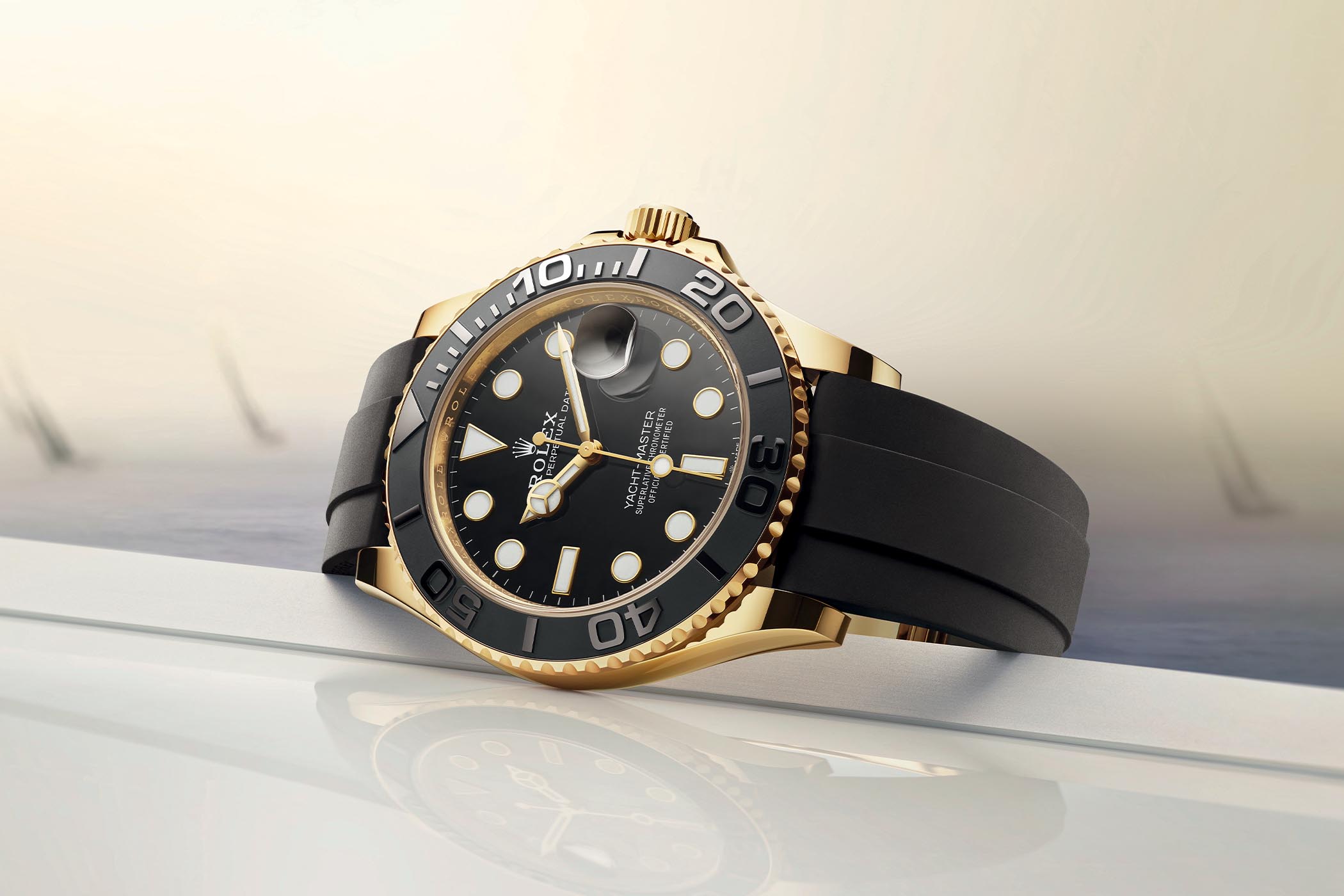
Yellow gold and black Cerachrom
The 42mm Oyster case of the new Yacht-Master is made from a solid block of 18k yellow gold and is waterproof to a depth of 100m. The distinctive bidirectional rotating bezel features a matte black Cerachrom insert with raised and mirror-polished graduations and numerals. Developed and patented by Rolex, Cerachrom is a hard ceramic material that is practically scratch-proof, corrosion-resistant and impervious to ultraviolet rays. The matte black ceramic has been sandblasted to provide a more technical, contemporary finish and provides the background for the raised black numerals marking 0-60 minutes. The knurled yellow gold edge means the bezel has a good grip, and the hermetically screwed-down caseback with its fine fluting on the edge ensure that only Rolex watchmakers can access the movement. Like all Yacht-Masters, the case is endowed with a Triplock winding crown and the dial protected by a sapphire crystal with a Cyclops lens at 3 o’clock to consult the date.
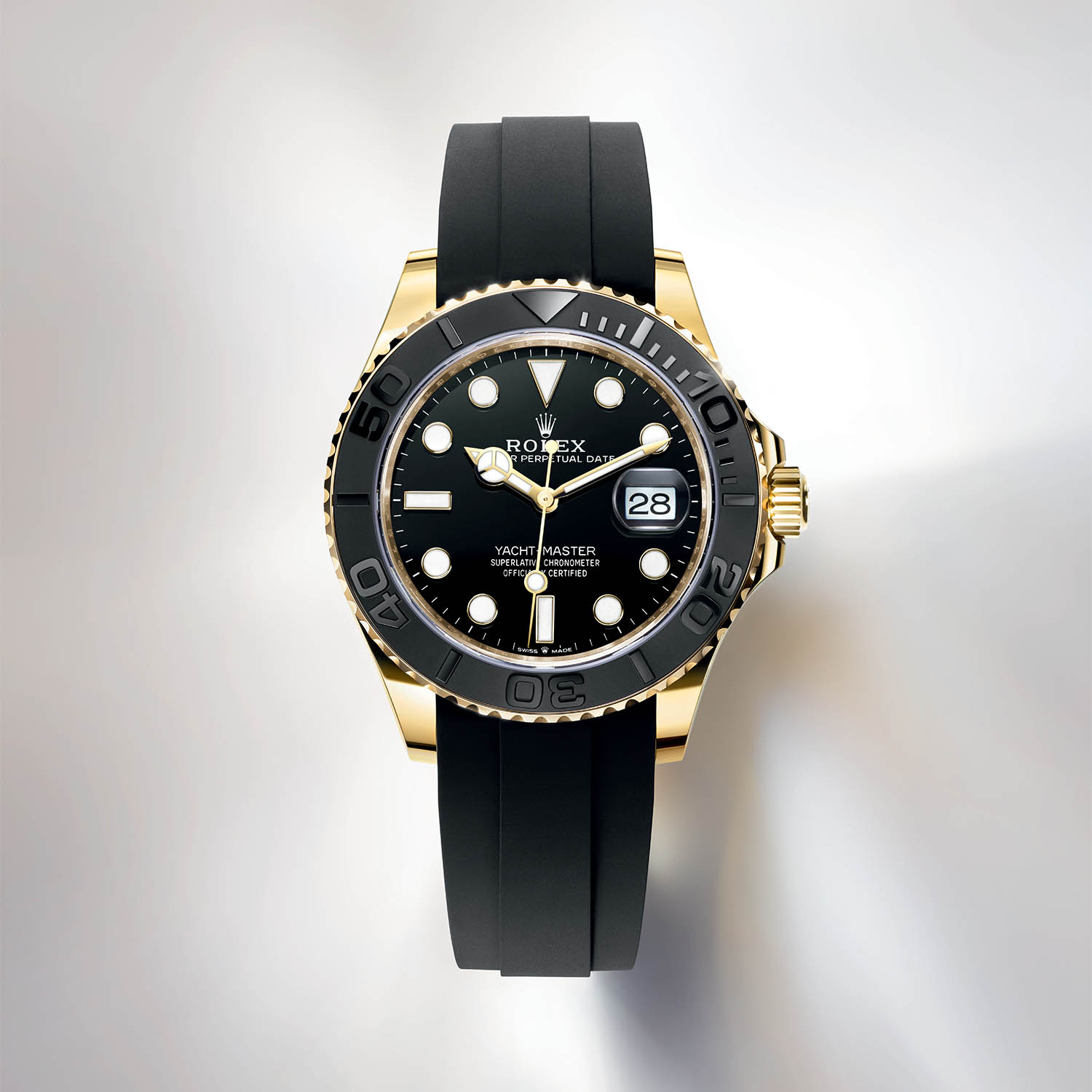
When Rolex released its Everose ref. 116655 of the Yacht-Master in 2015, the watch received two aesthetic updates that made it sleeker and more contemporary: the black ceramic Cerachrom insert and the high-tech black rubber Oysterflex strap. Although there are two-tone and Oystersteel and platinum versions of the Yacht-Master, the combination of a precious metal case with a black bezel, dial and rubber strap and the introduction of a 42mm case size in 2019 have given the Yacht-Master its distinctive, luxurious contemporary vibe. The lack of luminescent material on the bezel and the solid yellow gold case clearly take the Yacht-Master out of tool watch and professional dive watch waters and redirect it to activities above deck.
The black lacquered dial, which reinforces the sober aesthetics of this Rolex Yacht-Master 42, features applied yellow gold hour markers (triangular, round and rectangular) that are treated with Rolex’s very own luminescent material known as Chromalight that emits a long-lasting blue glow in the dark. The hallmark Mercedes hour hand, the minutes hand and the central seconds hand with its round counterweight are also crafted in gold with the same luminescent treatment as the hour markers.
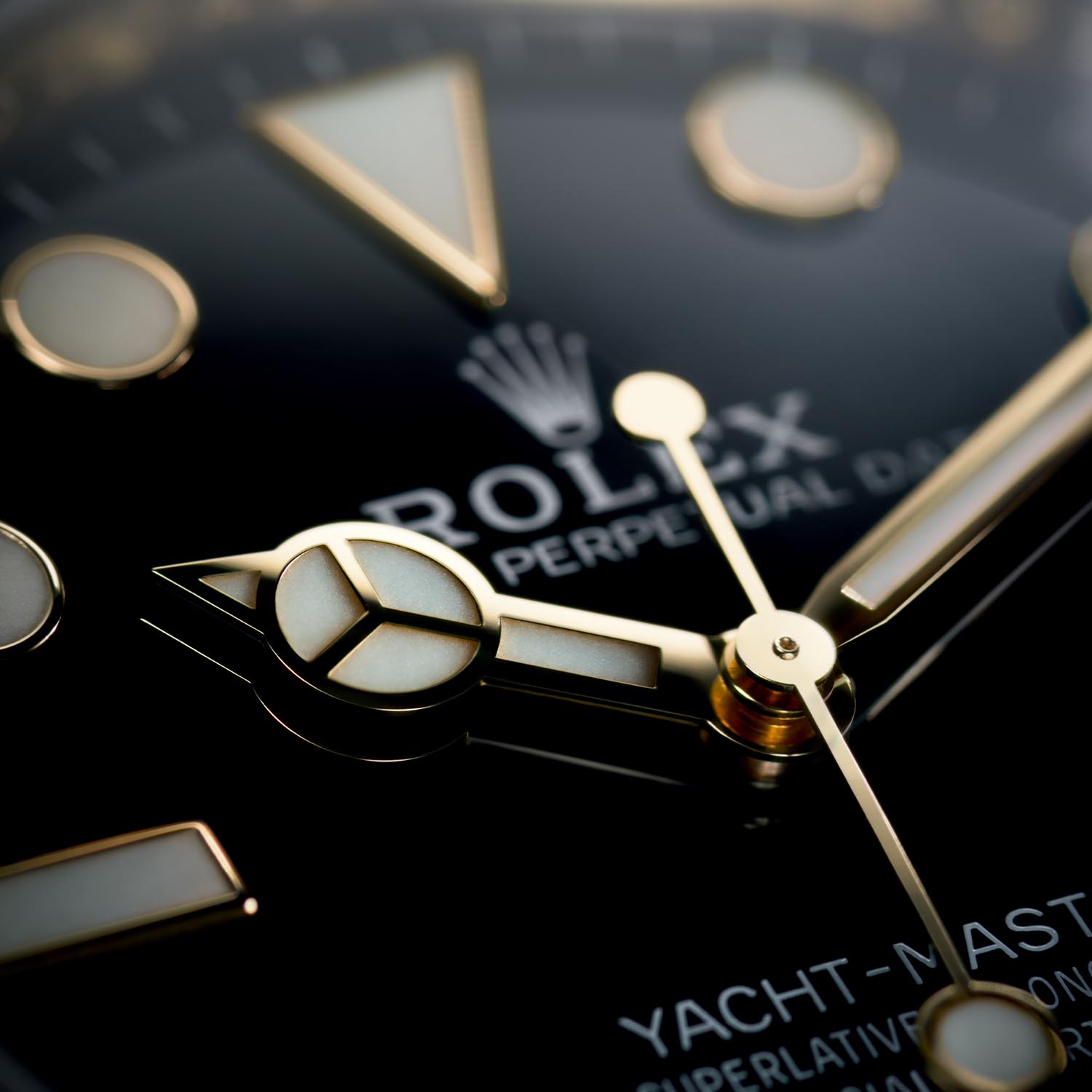
Calibre 3235
First introduced in 2015 to replace the long-serving calibre 3135, calibre 3235 is now Rolex’s flagship date-function movement and is protected by no fewer than 14 patents. The most significant innovation is the new Chronergy escapement. Made from anti-magnetic nickel-phosphorous, about half of the robust 70-hour power reserve can be attributed to the newly designed escapement. A Parachrom hairspring fitted on Paraflex shock absorbers, also insensitive to magnetic fields and temperature variations, offers ten times more precision than a traditional hairspring in case of shocks. Calibre 3235 was the first movement to receive Rolex’s own certification as a Superlative Chronometer with a tolerance of just -2/+2 seconds a day (more stringent than COSC).
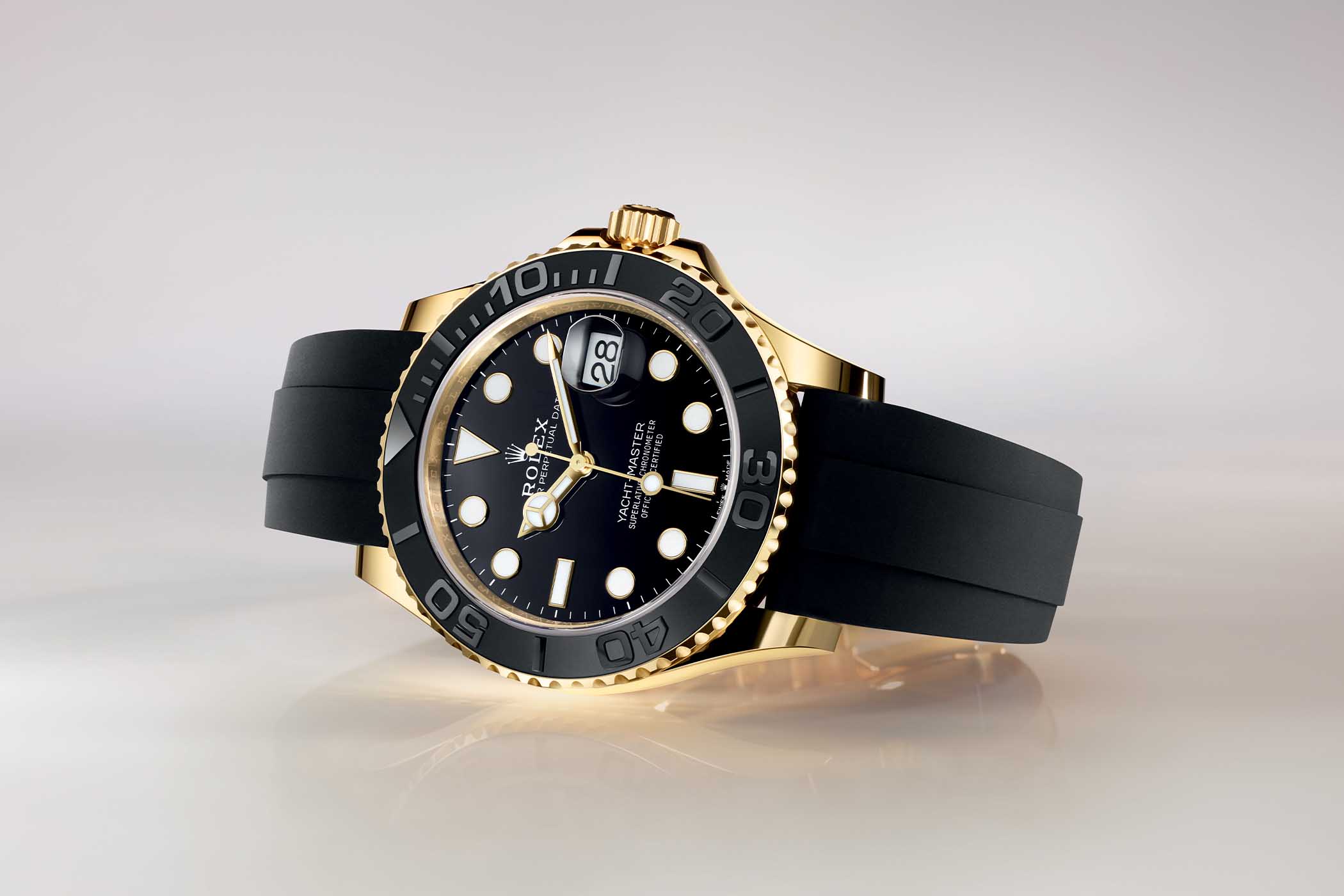
black Oysterflex bracelet
The matte black elastomer strap that has become a distinguishing feature of the Yacht-Master replicates the robustness and reliability of a metal bracelet with its hidden infrastructure of flexible and curved metal blades. The Oysterlock folding clasp in 18k yellow gold is fitted with a Glidelock extension system allowing for adjustments of 15mm without tools.
The Yacht-Master 42mm, reference 226658 in yellow gold, retails for EUR 26,700.
More information at Rolex.com .
Technical specifications – Rolex Yacht-Master 42
2 responses.
I might get 3 of these as there is a waiting list for the moonswatch.
Opinion: Most beautiful and “right sized” of the Rolex offering. I want one!
Leave a Reply Cancel reply
Top stories.
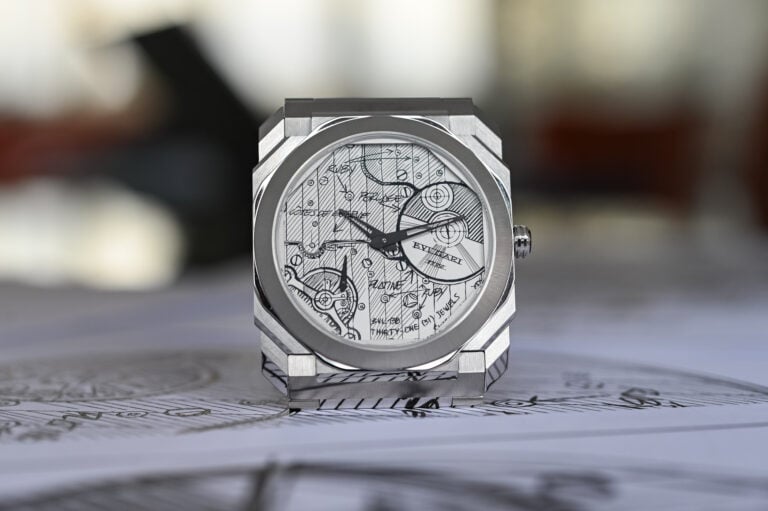
First Look Bulgari Drops a new Octo Finissimo Automatic Sketch Dial for its…
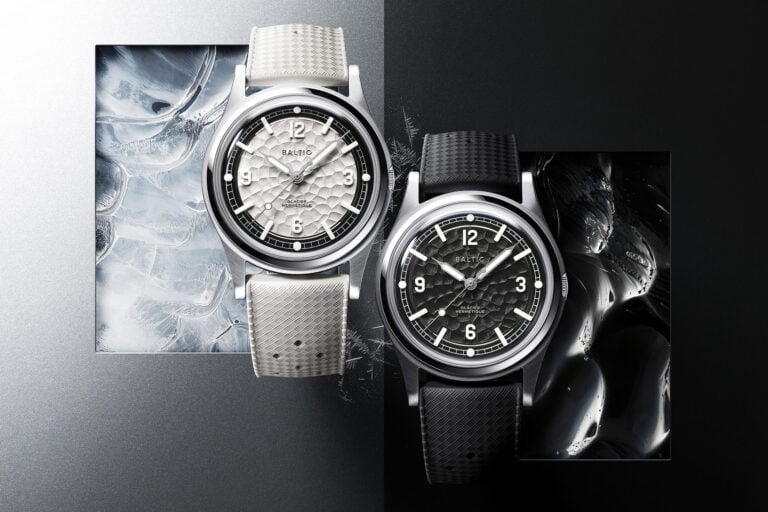
Introducing The New Baltic Hermétique Glacier Limited Edition Duo with Ice-Inspired Dials
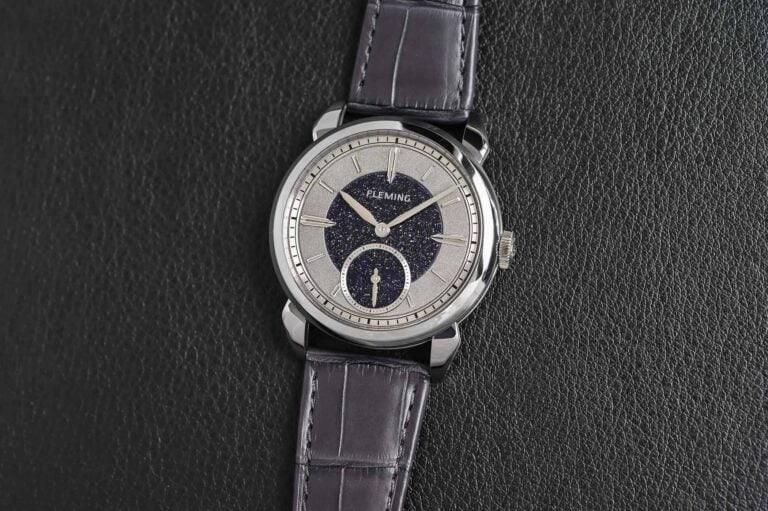
First Look New American Indie Watchmaker Fleming Presents its First Watch, the Series…
Subscribe to our newsletter, subscribe to our newsletter.
- ALL MOSCOW TOURS
- Getting Russian Visa
- Top 10 Reasons To Go
- Things To Do In Moscow
- Sheremetyevo Airport
- Domodedovo Airport
- Vnukovo Airport
- Airports Transfer
- Layover in Moscow
- Best Moscow Hotels
- Best Moscow Hostels
- Art in Moscow
- Moscow Theatres
- Moscow Parks
- Free Attractions
- Walking Routes
- Sports in Moscow
- Shopping in Moscow
- The Moscow Metro
- Moscow Public Transport
- Taxi in Moscow
- Driving in Moscow
- Moscow Maps & Traffic
- Facts about Moscow – City Factsheet
- Expat Communities
- Groceries in Moscow
- Healthcare in Moscow
- Blogs about Moscow
- Flat Rentals
Moscow parks – leisure, nature and historical
Moscow is the most green megapolis in the world. There are over a hundred parks and green spaces like gardens, squares and boulevards. You will definitely bump into a few of them wherever you go. Whether you are interested in memorial, historic parks, parks of wildlife or you just want to have a calm break from the speedy city life – city parks have something special for everyone.
Moscow leisure parks
The leisure Moscow parks are undoubtedly the most popular and famous with the locals and travelers. Today such parks provide a great number of exciting entertainments for Muscovites and city guests, adults and children.
The Gorky Park

Gorky Park opened in 1928 and was the first holiday park in the Soviet Union with playgrounds, a sports stadium, exhibition halls and attractions for kids. Today it has a fresh, vibrant appearance. The park features bike rental stations, a comfortable business area with Wi-Fi, an outdoor movie theatre and a greenhouse where you can buy fresh greens such as basil and lettuce. To contemplate the sky and the stars, go to the observatory and look through the telescope while listening to fascinating stories from astronomers. Enjoy many sports in the park: volleyball, handball, football or a peaceful jog around the beautiful surroundings.

Zaryadye Park
Opened in September 2017, Zaryadye is the youngest on our list. Located just a few minutes away from Red Square, it includes various activities like the floating bridge with its thin V-form extension, an ice cave, also concert hall and an amphitheater. The entire territory of the park was divided into four zones of Russia: forest, steppe, tundra, and the floodplains.
Neskuchny Sad

By walking along the Moskva River’s bank from the Gorky Park towards Vorobievy Gory (Sparrow Hills) you’ll reach Neskuchny Sad («Not Boring» garden), a wonderful place in the Moscow center, one of Moscow’s oldest parks, charming slice of wildlife. The park mostly consists of pristine forest, dotted with old summer pavilions, ponds and quaint little stone bridges. There are a lot of opportunities for different activities lots of children playground, a ping-pong and chess clubs, football fields and tennis courts, horse riding, tree climbing and having rest in one of the nice cafes.
Museon Park

Hermitage Garden

Hermitage Garden has always been known as an amusement, entertainment center with theatres, shows, cafes, summer pavilions, pergolas since 1830. Shalyapin, Sobinov, Nezhdanova – great Russian opera singers starred on the garden stage. Famous Russian composer Rakhmaninov conducted the orchestra. Sara Bernar, Maria Yermolova, outstanding actresses, played in the open air performances. Tolstoy and Lenin had a stroll in the garden. So lots of celebrities from different epoques liked it a lot and spent their time in Hermitage Garden. You can find here three theatres in the garden: Hermitage, Sphere and New Opera. During winter an ice rink works here and in summer a musical stage is assembled to host jazz and brass band festivals.

In Sokolniki Park visitors can play billiard, chess or draughts, table tennis, as well as go cycling, roller blading and swimming in the summer and ice skating or skiing in winter. Each season is highlighted by special memorable and bright events, for example, Summer Jazz Festival or Baby Fest (for future mums), open air beach disco parties, Ice Cream Day, International Clown Festival and many other shows and exhibitions. The park has an observatory, kids center and a co-working zone with free Wi-Fi which is really nice for spending high quality work time there.

Moscow nature parks
The nature parks are national reserves with the amazing forestry and incredible variety of animals and plants there. The breath of wildlife and the chance to be closer to the virgin nature excites both children and grownups. Hundreds of different species of animals can be found in Moscow nature parks. The richest woodlands with old and even ancient trees, like a 200 years pine-tree in the Elk Island National Nature Park, are the point of passionate interest for visitors.
Aptekarsky Ogorod

Aptekarsky Ogorod (Apothecary Garden)
Aptekarsky Ogorod (Apothecary Garden) is one of the oldest gardens in Moscow. It was founded in the XVIII century by Peter the First (great Russian emperor). A larch that he planted himself still grows in the garden, so it’s more than 250 years old. At the time of its foundation, it was a garden with herbs and medicinal plants and was used as an educational center for doctors. Today there are the orangery with its tropical palms, the carp pond, and the immense trees that dot the landscape and turn wonderful golden shades in the autumn. Several restaurants and cafes work here making it a very nice spot for relaxation no matter what season it is. You can book a special tour or join the guided excursion group.
Losiny Ostrov

Losiny Ostrov (Elk Island Park)
Losiny Ostrov (Elk Island Park) is located at the north of Moscow. It covers 22 km from the west to the east and 10 km from the north to the south and it’s one of the most beautiful national parks in Moscow. Two rivers, Yausa and Pechorka begin here. You can find lots of fields, ponds, meadows, streams in the park as well as elks. Here you can enjoy guided tours, available in English. You can choose a guided tour about flora and fauna of the area, you’ll learn why elks are there, which animals are their neighbors. Or enjoy another excursion, which is totally devoted to historical past of ancient tribes once lived there, you’ll know about old Russian mythology, rituals and traditions.
Serebyany Bor

Serebyany Bor (Silver Forest)
Serebyany Bor (Silver Forest) is a famous pine forest in the west of Moscow. The park has 230 forms of plant life, and is also home to watersports complex, providing a lot of activities for visitors. The layout of Serebryany Bor is unusual, as it is located on an artificial island between a meander in the Moscow River and a channel. There is an artificial lake, the Deep Gulf and picturesque Bezdonnoe (Bottomless) Lake in the depths of the forest. Serebryany Bor’s beaches are the cleanest in the city and very popular among Muscovites. On weekends it is difficult to find a free spot here, especially because a whole range of services are offered to visitors, from simple deckchairs to catamaran and yacht rides. Driving is prohibited on the territory of the island so be ready to use trolleybus to reach the entrance.
Botanichesky Sad

Greenhouse of Botanical Garden
Main Botanical Garden of The Russian Academy of Sciences is the largest and most famous is Moscow. The garden is a real museum of nature with a very rich (more than 18000 types) collection of plants. The park was founded in 1945 at the place of the 17th century Apothecaries’ Gardens. The garden’s collection is turned into botanical expositions, made with use of modern receptions of landscape architecture. Here you can see a tree nursery, a shadow garden, hothouse complex, collection of flowers, a rosary, exposition of coastal plants, garden of continuous blossoming, Japanese garden and expositions of cultural plants and natural flora plants. The biggest part of Garden is the Tree nursery occupying the space of 75 hectares. About 2 thousand wood plants grow here. Another big exposition of the Garden is nature Flora, divided into six botanic-geographical collections: European part of Russia, Caucuses, Central Asia, Siberia and Far East. Pride of the Main Botanical Garden is the collection of tropical, coastal and water plants, which is considered as the best in Europe. The Japanese garden, a great model of Japanese landscape gardening art has a 13-level stone pagoda of the 18th century, stone Japanese lamps, ponds, falls and streams, tea lodges and more than 100 species of the most character Japan plants. It is especially decorative in spring, during Oriental cherry blossoming and in fall, when foliage blazes in crimson colors.
Moscow historic parks
Historic nature parks and estates once were the mansions of the Moscow aristocracy. At that far times the estates were outside the Moscow city limits, but after the city expansion and urbanization, they became easily accessible.
Kolomenskoye

Kolomenskoye Museum and Park
The chief attraction of the park is undoubtedly the stone Church of the Ascension of the Lord. It was constructed in 1532 by order of Tsar Vasily III to commemorate the birth of his son and heir, Ivan the Terrible. But there is a lot more to see in the park: the pretty Church of the Icon of Our Lady of Kazan – with its bright azure domes and plenty of gold. Further into the park there is a charming Church of the Beheading of St John the Baptist, built by Ivan the Terrible to mark his coronation.

Kuskovo Park
Kuskovo Park is one of the oldest country estates in Moscow. It was given to General Sheremetev by Peter the Great in 1715, but was left to fall into neglect before being plundered by Napoleon’s troops in 1812. Nowadays the estate has been restored to its former glory and is a good example of Russian 18th Century imperial architecture. The palace is a fine and rare example of wooden neoclassicism. It was completed in 1775, and the rich interiors remain unchanged since 1779. It includes a room hung with exclusive exquisite Flemish tapestries, an abundance of silk wallpaper and an impressive collection of 18th century European and Russian paintings. The palace looks onto the lake, which is surrounded by smaller pavilions: pretty Italian, Dutch and Swiss Cottages, Blank’s Hermitage and the old Orangery, where the State Ceramics Museum is located now, an extensive and absorbing collection of porcelain from the 18th century to the present day. On the other side of the lake is a large wood popular with local cyclists and joggers.
Our Private Tours in Moscow
Moscow metro & stalin skyscrapers private tour, moscow art & design private tour, soviet moscow historical & heritage private tour, gastronomic moscow private tour, «day two» moscow private tour, layover in moscow tailor-made private tour, whole day in moscow private tour, all-in-one moscow essential private tour, tour guide jobs →.
Every year we host more and more private tours in English, Russian and other languages for travelers from all over the world. They need best service, amazing stories and deep history knowledge. If you want to become our guide, please write us.

Contact Info
+7 495 166-72-69
119019 Moscow, Russia, Filippovskiy per. 7, 1
Mon - Sun 10.00 - 18.00
- Bahasa Indonesia
- Slovenščina
- Science & Tech
- Russian Kitchen
Cruising the Moskva River: A short guide to boat trips in Russia’s capital

There’s hardly a better way to absorb Moscow’s atmosphere than on a ship sailing up and down the Moskva River. While complicated ticketing, loud music and chilling winds might dampen the anticipated fun, this checklist will help you to enjoy the scenic views and not fall into common tourist traps.
How to find the right boat?
There are plenty of boats and selecting the right one might be challenging. The size of the boat should be your main criteria.
Plenty of small boats cruise the Moskva River, and the most vivid one is this yellow Lay’s-branded boat. Everyone who has ever visited Moscow probably has seen it.

This option might leave a passenger disembarking partially deaf as the merciless Russian pop music blasts onboard. A free spirit, however, will find partying on such a vessel to be an unforgettable and authentic experience that’s almost a metaphor for life in modern Russia: too loud, and sometimes too welcoming. Tickets start at $13 (800 rubles) per person.
Bigger boats offer smoother sailing and tend to attract foreign visitors because of their distinct Soviet aura. Indeed, many of the older vessels must have seen better days. They are still afloat, however, and getting aboard is a unique ‘cultural’ experience. Sometimes the crew might offer lunch or dinner to passengers, but this option must be purchased with the ticket. Here is one such option offering dinner for $24 (1,490 rubles).

If you want to travel in style, consider Flotilla Radisson. These large, modern vessels are quite posh, with a cozy restaurant and an attentive crew at your service. Even though the selection of wines and food is modest, these vessels are still much better than other boats.

Surprisingly, the luxurious boats are priced rather modestly, and a single ticket goes for $17-$32 (1,100-2,000 rubles); also expect a reasonable restaurant bill on top.
How to buy tickets?
Women holding photos of ships promise huge discounts to “the young and beautiful,” and give personal invitations for river tours. They sound and look nice, but there’s a small catch: their ticket prices are usually more than those purchased online.
“We bought tickets from street hawkers for 900 rubles each, only to later discover that the other passengers bought their tickets twice as cheap!” wrote (in Russian) a disappointed Rostislav on a travel company website.
Nevertheless, buying from street hawkers has one considerable advantage: they personally escort you to the vessel so that you don’t waste time looking for the boat on your own.

Prices start at $13 (800 rubles) for one ride, and for an additional $6.5 (400 rubles) you can purchase an unlimited number of tours on the same boat on any given day.
Flotilla Radisson has official ticket offices at Gorky Park and Hotel Ukraine, but they’re often sold out.
Buying online is an option that might save some cash. Websites such as this offer considerable discounts for tickets sold online. On a busy Friday night an online purchase might be the only chance to get a ticket on a Flotilla Radisson boat.
This website (in Russian) offers multiple options for short river cruises in and around the city center, including offbeat options such as ‘disco cruises’ and ‘children cruises.’ This other website sells tickets online, but doesn’t have an English version. The interface is intuitive, however.
Buying tickets online has its bad points, however. The most common is confusing which pier you should go to and missing your river tour.

“I once bought tickets online to save with the discount that the website offered,” said Igor Shvarkin from Moscow. “The pier was initially marked as ‘Park Kultury,’ but when I arrived it wasn’t easy to find my boat because there were too many there. My guests had to walk a considerable distance before I finally found the vessel that accepted my tickets purchased online,” said the man.
There are two main boarding piers in the city center: Hotel Ukraine and Park Kultury . Always take note of your particular berth when buying tickets online.
Where to sit onboard?
Even on a warm day, the headwind might be chilly for passengers on deck. Make sure you have warm clothes, or that the crew has blankets ready upon request.
The glass-encased hold makes the tour much more comfortable, but not at the expense of having an enjoyable experience.

Getting off the boat requires preparation as well. Ideally, you should be able to disembark on any pier along the way. In reality, passengers never know where the boat’s captain will make the next stop. Street hawkers often tell passengers in advance where they’ll be able to disembark. If you buy tickets online then you’ll have to research it yourself.
There’s a chance that the captain won’t make any stops at all and will take you back to where the tour began, which is the case with Flotilla Radisson. The safest option is to automatically expect that you’ll return to the pier where you started.
If using any of Russia Beyond's content, partly or in full, always provide an active hyperlink to the original material.
to our newsletter!
Get the week's best stories straight to your inbox
- What to do in Moscow City, if you’re not mega-rich
- Moscow after dusk: 10 places to drink, dance, and groove
- 5 things you must do in Moscow in 2018 between football matches (or without them)
- Sandwiched between Moscow and St. Petersburg: How to spend a perfect weekend in Tver
- 24 or 48 hours in Moscow: Where to go and what to do in 2019
This website uses cookies. Click here to find out more.
Flotilla Radisson Royal
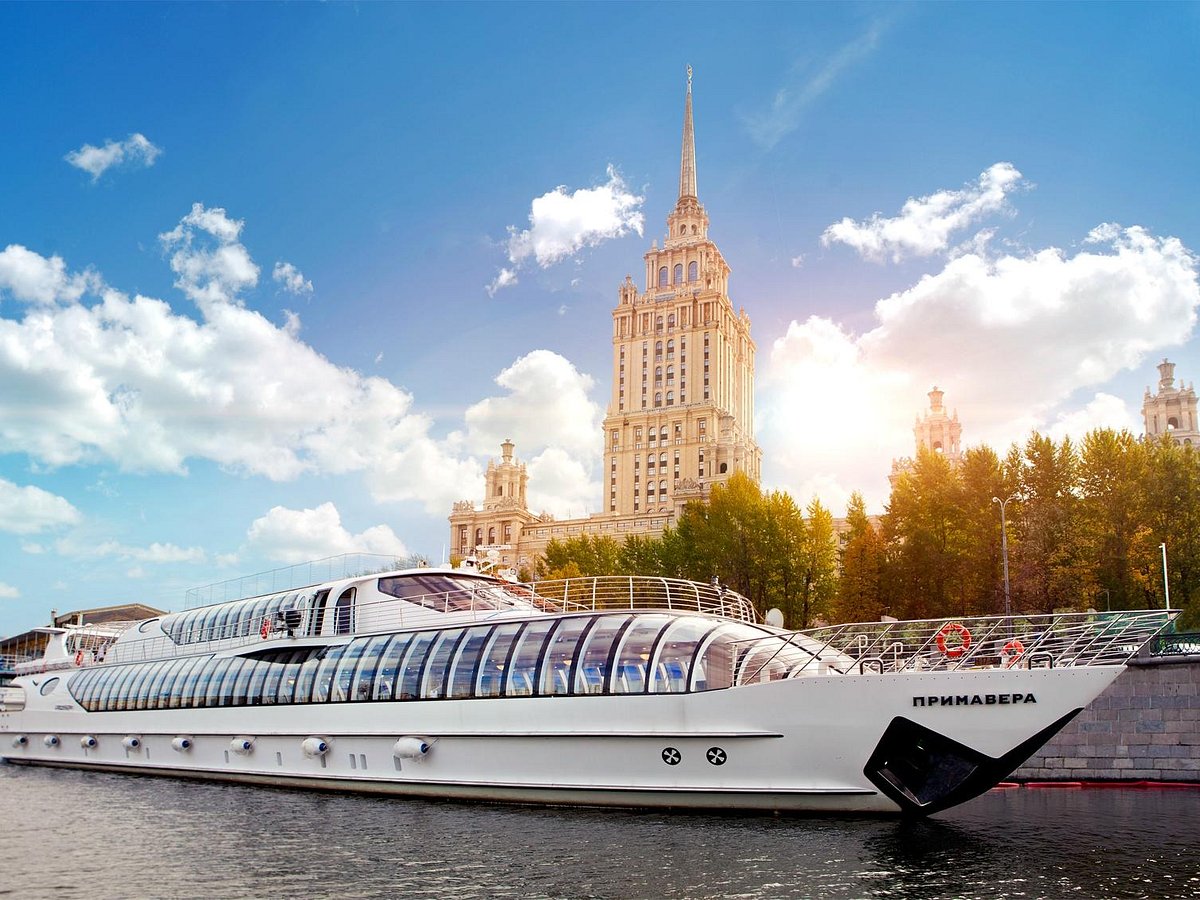
- See all photos

Most Recent: Reviews ordered by most recent publish date in descending order.
Detailed Reviews: Reviews ordered by recency and descriptiveness of user-identified themes such as wait time, length of visit, general tips, and location information.
Flotilla Radisson Royal - All You Need to Know BEFORE You Go (2024)
Three decades after the Soviet era, this Moscow street echoes what was.
And hints where russia is heading., welcome to tverskaya street.
MOSCOW — Thirty years ago, the Soviet Union ceased to be. The flag was lowered for the last time on Dec. 25, 1991. That moment still raises deep questions for the U.S.S.R.’s heirs: “Who were we as Soviets, and where are we going as Russians?”
Many of the answers can be found on Moscow’s main thoroughfare — named Gorky Street, after writer Maxim Gorky, from 1932 to 1990, and renamed Tverskaya Street, a nod to the ancient city of Tver, as the Soviet Union was awash in last-gasp reforms.
It was the Soviet Union’s display window on the bright future that Kremlin-run communism was supposed to bring. It was where the KGB dined, the rich spent their rubles, Vladimir Lenin gave speeches from a balcony, and authorities wielded their power against one of the most famous Soviet dissidents, Alexander Solzhenitsyn.

In the 1990s, Tverskaya embodied the fast-money excesses of the post-Soviet free-for-all. In later years, it was packed with hopeful pro-democracy marchers. And now , under President Vladimir Putin, it is a symbol of his dreams of reviving Russia as a great power, reliving past glories and crushing any opposition to his rule.
Join a tour of Moscow’s famed Tverskaya Street.
Hotel National: Where the Soviet government began
The window in Room 107 at the Hotel National faces Red Square and the Kremlin. It offers a perfect view of Lenin’s tomb — fitting, since he was Room 107’s most famous guest.
The Kremlin was damaged during the Russian Revolution in 1917. So Lenin and his wife moved into Room 107 for seven days in March 1918, making the hotel the first home of the Soviet government.

The Hotel National in Moscow, from top: Artwork in the Socialist Realist style — which artists were ordered to adopt in the 1930s — still adorns the hotel; Elena Pozolotina has worked at the hotel since 1995; the hotel, which contains a restaurant, was built in 1902; the National has hosted notable guests, including Soviet leader Vladimir Lenin, then-Sen. Barack Obama (D-Ill.) and actor Jack Nicholson. (Photos by Arthur Bondar for The Washington Post)
The National, built in 1902 during the era of Imperial Russia, also accommodated other Soviet leaders, including Leon Trotsky and Felix Dzerzhinsky, chief of the secret police. The building continued to be used by the Soviet government as a hostel for official party delegates and was renamed First House of Soviets in 1919.
Guests can now stay in the same room Lenin did for about $1,300 a night. In more recent years, the hotel has hosted notable guests including Barack Obama (when he was a senator) and actor Jack Nicholson.
“This hotel feels a little like a museum,” said Elena Pozolotina, who has worked at the National since 1995.
“We have rooms that look onto Tverskaya Street, and we always explain to guests that this is the main street of our city,” Pozolotina said. “This corner of Tverskaya that we occupy, it’s priceless.”
Stalin’s plan: ‘The building is moving’
When Soviet leader Joseph Stalin demanded a massive redevelopment of Moscow in 1935, an order came to transform modest Gorky Street into a wide, awe-inspiring boulevard.
Engineer Emmanuel Gendel had the job of moving massive buildings to make way for others. Churches and monasteries were blown up, replaced by newspaper offices and a huge cinema.
The Moscow Central Eye Hospital was sheared from its foundation, rotated 97 degrees, jacked up, hitched on rails and pushed back 20 yards — with surgeons operating all the while, or so official media reported at the time.

Gendel’s daughter, then about 8, proudly stood at a microphone, announcing: “Attention, attention, the building is moving.” Tatiana Yastrzhembskaya, Gendel’s granddaughter and president of the Winter Ball charity foundation in Moscow, recalls that Gendel extolled communism but also enjoyed the rewards of the elite. He drove a fine car and always brought the family the best cakes and candies, she said.
The largest Gorky Street building Gendel moved was the Savvinskoye Courtyard. The most difficult was the Mossoviet, or Moscow city hall, with a balcony where Lenin had given speeches. The building, the former residence of the Moscow governor general, had to be moved with its basement. The ground floor had been a ballroom without central structural supports.

Moving buildings on Gorky Street in 1940, from left: A mechanic at a control panel regulates the supply of electricity while a house is being moved; a postal worker passes a moving house; a specialist unwinds a telephone cable during a building move to maintain uninterrupted communication; 13 rail tracks were placed under a house, on which 1,200 metal rollers were laid. (Photos by RGAKFD)
Gendel’s skills were used all over the U.S.S.R. — straightening towers on ancient mosques in Uzbekistan, inventing a means to drag tanks from rivers during World War II and consulting on the Moscow Metro.
Like many of the Soviet Union’s brightest talents, Gendel found that his freedom was tenuous. His ex-wife was called by the KGB internal spy agency in 1937 and asked to denounce him. She refused, and he avoided arrest.

“I believe he was not arrested and sent to the camps because he was a unique expert,” said Yastrzhembskaya. World War II, known in Russia as the Great Patriotic War, interrupted the Master Plan for Gorky Street.
Aragvi restaurant: A haunt of the KGB
In the 1930s, the head of the elite NKVD secret police, Lavrenty Beria, one of the architects of the Stalin-era purges, ordered the construction of a state-owned restaurant, Aragvi, to showcase food from his home republic of Georgia.
One night, NKVD agents descended in several black cars on a humble Georgian canteen in Moscow that Beria had once visited. The agents ordered the chef, Longinoz Stazhadze, to come with them. The feared NKVD was a precursor to the KGB.
Stazhadze thought he was being arrested, his son Levan told Russian media. He was taken to Beria, who said that he had agreed with “the Boss” (Stalin) that Stazhadze would run Aragvi. Stazhadze had grown up a peasant, sent to work in a prince’s kitchens as a boy.

Aragvi opened in 1938. It was only for the gilded set, a reminder that the “Soviet paradise” was anything but equitable. The prices were astronomical. It was impossible to get a table unless the doorman knew you or you could pay a hefty bribe.
Aragvi, at No. 6 Tverskaya, was a favorite of the secret police; government officials; cosmonauts and pilots; stars of theater, movies and ballet; directors; poets; chess masters. Beria reputedly dined in a private room. Poet Sergei Mikhalkov said he composed the lyrics of the Soviet national anthem while sitting in the restaurant in 1943.
It was privatized in the 1990s and struggled, before closing in 2002. It reopened in 2016 after a $20 million renovation. But the new Aragvi closed abruptly in 2019 amid reports of a conflict between its owner and the building managers.
“You put your entire soul into cooking,” said the former head chef, Nugzar Nebieridze, 59, celebrated for his khinkali, a meaty dumpling almost the size of a tennis ball. He was devastated to find himself unemployed. But other doors opened. He now prefers to travel, giving master classes around Russia.
Stalin’s funeral: A deadly street crush that never officially happened
On March 6, 1953, the day after Stalin died of a stroke, an estimated 2 million Muscovites poured onto the streets. They hoped to catch a glimpse of his body, covered with flowers and laid out in the marbled Hall of Columns near Red Square.
Yulia Revazova, then 13, sneaked from her house with her cousin Valery without telling their parents. As they walked toward Pushkin Square, at one end of Gorky Street, the procession turned into a scene of horror. They saw people falling and being trampled. Some were crushed against metal fences. Valery, who was a few years older, grabbed Yulia by the hand and dragged her out of the crowd.

“He held my hand really tight and never let it go, because it was pure madness,” she recalled recently. “It took us four or five hours to get out of there. People kept coming and coming. I couldn’t even call it a column; it was just an uncontrollable mass of people.”
“I still have this feeling, the fear of massive crowds,” added Revazova, 82. “To this day, if I see a huge group of people or a really long line, I just cross the street.”
Neither Revazova nor her cousin knew about Stalin’s repressions.
“People were crying. I saw many women holding little handkerchiefs, wiping away tears and wailing,” she recalled. “That’s the psychology of a Soviet person. If there is no overarching figure above, be it God or Lenin, life will come crashing down. The era was over, and there was fear. What will we do without Stalin?”
Officials never revealed how many people died that day. The Soviet-approved archival footage of the four days of national mourning showed only orderly marches and memorials.
No. 9: The ruthless culture minister
The Soviet culture minister, the steely Yekaterina Furtseva, was nicknamed Catherine the Third, after the forceful Russian Empress Catherine the Great. Furtseva destroyed writers, artists or anyone else who challenged Soviet ideas. She lived at an elite 1949 apartment building for government officials at No. 9 — an ultra-prestigious address with a view of the Kremlin.
Furtseva, a former small-town weaver, made sure that No. 9 was only for the cream of party officials and other notables, such as famous Soviet actress Natalia Seleznyova, scientists, conductors and architects.
Riding the coattails of Soviet leader Nikita Khrushchev, Furtseva was the only woman in the Politburo and later became the Soviet Union’s cultural gatekeeper despite her provincial sensibilities. She once infamously mixed up a symphony with an opera, and critics were quick to notice.

“She had little in common with the artistic leaders of her country except a liking for vodka,” Norwegian painter Victor Sparre wrote in his 1979 book on the repression of dissident Soviet writers, “The Flame in the Darkness.”
Furtseva was famous for previewing performances and declaring anyone even subtly critical of Soviet policies as being anti-state. Director Yuri Lyubimov described one such visit to Moscow’s Taganka Theater in 1969, when she turned up wearing diamond rings and an astrakhan coat. She banned the play “Alive,” depicting a cunning peasant’s struggle against the collective farm system. She “was livid, she kept shouting,” he told L’Alternative magazine in 1984. She stormed out, warning him she would use her influence, “up to the highest levels,” against him.
He was expelled from the party and in 1984 was stripped of his citizenship. She vehemently denounced Solzhenitsyn, and banned the Bolshoi Ballet’s version of “Carmen” in 1967 over prima ballerina Maya Plisetskaya’s sensual performance and “un-Soviet” costumes that did not cover enough leg.
“The ballet is all erotica,” she told the dancer. “It’s alien to us.” But Plisetskaya, whom Khrushchev once called the world’s best dancer, fought back. The ballet went on with some excisions (the costumes stayed) and became a legend in the theater’s repertoire.
Furtseva was nearly felled by scandal in 1974, ordered to repay $80,000 spent building a luxurious dacha, or country home, using state labor. She died months later.

Where Solzhenitsyn was arrested
The Nobel Prize-winning Solzhenitsyn exposed the Soviet system’s cruelty against some of its brightest minds, trapped in the gulag, or prison camps.
Solzhenitsyn was given eight years of hard labor in 1945 for privately criticizing Stalin, then three years of exile in Kazakhstan, a Soviet republic at the time. His books were banned. After release from exile in 1956, he was allowed to make only 72-hour visits to the home of his second wife, Natalia, at 12 Gorky St., Apt. 169. Solzhenitsyn had to live outside the city.
“People knew that there were camps, but not many people, if any, knew what life was like in those camps. And he described it from the inside. He had been there himself, and that was shocking to a lot of people,” said Natalia Solzhenitsyna during a recent interview at the apartment, which became a museum in 2018.
“Many people say that he did make a contribution to the final fall of the Soviet Union.”
Solzhenitsyn, who died in 2008, called Russia “the land of smothered opportunities.” He wrote that it is always possible to live with integrity. Lies and evil might flourish — “but not through me.”
The museum displays tiny handwritten copies of Solzhenitsyn’s books, circulated secretly; film negatives of letters smuggled to the West; and beads made of compacted bread that he used to memorize poems in prison.
“He spent a lot of time here with his children. We were always very busy. And we just enjoyed ourselves — being together,” Solzhenitsyna said. They had three sons.

No. 12 Gorky St., from top: Natalia Solzhenitsyna lived in the apartment for years, and her husband, Soviet dissident Alexander Solzhenitsyn, was allowed only short visits; the site now houses a museum displaying items connected to him, such as negatives containing a copy of a novel he wrote; another exhibit includes Solzhenitsyn’s clothes from when he was sent to the gulag and beads made of compacted bread that he used to memorize poems; the Nobel Prize-winning writer’s desk is featured at the museum. (Photos by Arthur Bondar for The Washington Post)
Because of KGB bugs, if the couple were discussing something sensitive, they wrote notes to each other, and then destroyed them. Two KGB agents usually roosted in the stairwell on the floor above, with two more on the floor below.
“The Soviet authorities were afraid of him because of his popularity among intellectuals, writers, people of culture and the intelligentsia.”
Her favorite room is decked with black-and-white photos of dissidents sent to the gulag, the Soviet Union’s sprawling system of forced labor camps. “It’s dedicated to the invisibles,” she said, pointing out friends.
Sweden planned to award Solzhenitsyn’s 1970 literature prize in the Gorky Street apartment, but the writer rejected a secret ceremony. A Swedish journalist in Moscow, Stig Fredrikson, was Solzhenitsyn’s smuggler. He carried Solzhenitsyn’s Nobel lecture on tightly rolled film disguised as a battery in a transistor radio, and he took other letters to the West and transported photos taped to his back.
“I felt that there was a sense of unfairness that he was so isolated and so persecuted,” Fredrikson said in a recent interview. “I got more and more scared and more and more afraid every time I met him.”
In 1971, the Soviet Union allegedly tried to poison Solzhenitsyn using a secret nerve agent, leaving him seriously ill. Early 1974 was tense. The prosecutor subpoenaed him. State newspapers railed against him.
The morning of Feb. 12, 1974, the couple worked in their study. In the afternoon, he walked his 5-month-old son, Stepan, in the yard below.
“He came back here, and literally a minute later, there was a ring at the door. There were eight men. They immediately broke the chain and got in,” his widow said. “There was a prosecutor in his prosecutor’s uniform, two men in plainclothes, and the rest were in military uniform. They told him to get dressed.”
“We hugged and we kept hugging for quite a while,” she recalled. “The last thing he told me was to take care of the children.”
He was deported to West Germany. The couple later settled in Vermont and set up a fund to help dissident writers, using royalties from his book “The Gulag Archipelago.” About 1,000 people still receive money from the fund, according to Solzhenitsyna.
When the writer and his wife returned to Russia in 1994, they traveled across the country by train. Thousands of people crushed into halls to hear him speak.
Solzhenitsyn abhorred the shock therapy and unchecked capitalism of the 1990s and preferred Putin’s tough nationalism. He died of heart failure at 89 in August 2008, five months after a presidential election in which Putin switched places with the prime minister, Dmitry Medvedev, in a move that critics saw as a ploy to get around constitutional term limits.
No. 6: ‘Feasts of thought’
Behind a grand Stalin-era apartment block at 6 Gorky St. sits an ornate 1907 building famous for its facade, art nouveau glazed blue tiles, elegant arches and baroque spires. Once a monastery dormitory, it was a staple of pre-Soviet postcards from Moscow. But in November 1939, the 26,000-ton building was put on rails and pushed back to widen the street.
Linguists Lev and Raisa Kopelev lived in Apt. 201 on the top floor. Their spacious dining room became a favored haven for Moscow’s intelligentsia from the 1950s to the 1980s.

“People gathered all the time — to talk. In this apartment, like many other kitchens and dining rooms, at tables filled more often than not with vodka, herring and vinaigrette salad, feasts of thought took place,” said Svetlana Ivanova, Raisa’s daughter from another marriage, who lived in the apartment for nearly four decades.
Solzhenitsyn and fellow dissident Joseph Brodsky were Kopelev family friends, as were many other artists, poets, writers and scientists who formed the backbone of the Soviet human rights movement of the 1960s.
As a writer and dissident, Kopelev had turned his back on the Communist Party and a prestigious university position. The onetime gulag prisoner inspired the character Lev Rubin in Solzhenitsyn’s novel “In the First Circle,” depicting the fate of arrested scientists.
“The apartment was a special place for everyone. People there were not afraid to speak their mind on topics that would be considered otherwise risky,” Ivanova said. “A new, different spirit ruled in its walls.”
Eliseevsky: Pineapples during a famine
The Eliseevsky store at No. 16 was a landmark for 120 years — born in czarist Russia, a witness to the rise and fall of the Soviet Union, a survivor of wars, and a bastion during eras of shortages and plenty. It closed its doors in April.
Eliseevsky fell on hard times during the coronavirus pandemic, as international tourists dwindled and Russians sought cheaper grocery-shopping alternatives.
In the palace-like interior, two chandeliers hang from an ornate ceiling. Gilt columns line the walls. The front of the store, looking out at Tverskaya Street, has a row of stained glass.

The Eliseevsky store, which opened in 1901, is seen in April, with a few customers and some archival photos, as it prepared to close as an economic victim of the coronavirus pandemic. (Photos by Arthur Bondar for The Washington Post)
Denis Romodin, a historian at the Museum of Moscow, said Eliseevsky is one of only two retail spaces in Moscow with such pre-revolutionary interiors. But Eliseevsky’s level of preservation made it “one of a kind,” he said.
The building was once owned by Zinaida Volkonskaya, a princess and Russian cultural figure in the 19th century. She remodeled the house into a literary salon whose luminaries included Russia’s greatest poet, Alexander Pushkin.
St. Petersburg merchant Grigory Eliseev opened the market in 1901. It quickly became a hit among Russian nobility for its selection of European wines and cheeses.

Romodin said it was Russia’s first store with price tags. Before Eliseevsky, haggling was the norm. And it was also unique in having innovative technology for the time: electric-powered refrigerators and display cases that allowed goods to be stored longer.
Even in the Soviet Union’s hungriest years, the 1930s famine, Eliseevsky stocked pineapples.
“One could find outlandish delicacies here, which at that time seemed very exotic,” Romodin said. “It was already impossible to surprise Muscovites with wine shops. But a grocery store with luxurious interiors, and large for that time, amazed and delighted Muscovites.”

The First Gallery: A glimpse of openness
In 1989, in a dusty government office by a corner of Pushkin Square, three young artists threw off decades of suffocating state control and opened the Soviet Union’s first independent art gallery.
That April, Yevgeny Mitta and two fellow students, Aidan Salakhova and Alexander Yakut, opened First Gallery. At the time, the Soviet Union was opening up under policies including glasnost, which gave more room for public debate and criticism.
Artists were ordered to adopt the Socialist Realist style in 1934, depicting scenes such as happy collective farmworkers. Expressionist, abstract and avant-garde art was banned. From the 1970s, underground art exhibitions were the only outlets to break the Soviet-imposed rules.

The First Gallery, from top: Yevgeny Mitta, Aidan Salakhova and Alexander Yakut opened the Soviet Union’s first independent art gallery in 1989 and received media attention; Mitta works on a painting that he displayed at his gallery; Mitta recalled recently that he “felt we had to make something new”; an undated photo of Mitta at his gallery in Soviet times. (Photos by Arthur Bondar for The Washington Post and courtesy of Yevgeny Mitta)
“I just felt we had to make something new,” recalled Mitta, 58, who kept his interest in contemporary expressionism a secret at a top Moscow art school in the 1980s.
“It was like nothing really happened in art history in the 20th century, like it stopped,” he said. “The Socialist Realism doctrine was invented and spread to the artists as the only one, possible way of developing paintings, films and literature.”
After the collapse of the Soviet Union, artists had to “learn how to survive, what to do, how to work and make a living,” he said.
McDonald’s: ‘We were not used to smiling’
In the Soviet Union’s final years, a mania raged for all things Western. Estée Lauder opened the first Western-brand shop on Gorky Street in 1989, after meeting Raisa Gorbachev, the wife of reformist Soviet leader Mikhail Gorbachev, in December 1988.
The Soviet Union’s first McDonald’s, located across Pushkin Square on Gorky Street, opened on Jan. 31, 1990 — a yellow-arched symbol of Gorbachev’s perestroika economic reforms. Pizza Hut opened later that year. (In 1998, Gorbachev starred in a commercial for the pizza chain.)
Karina Pogosova and Anna Patrunina were cashiers at the McDonald’s on opening day. The line stretched several blocks. Police officers stood watch to keep it organized.

The Soviet Union’s first McDonald’s opened in 1990 and eager customers lined up to enter; Karina Pogosova, left, and Anna Patrunina were cashiers at the fast-food restaurant on Gorky Street then, and they are senior executives with the company today. (Photos by Peter Turnley/Corbis/VCG/Getty Images and Arthur Bondar for The Washington Post)
“The atmosphere was wonderful. The first day I had to smile the entire day and my face muscles hurt,” Patrunina said. “This is not a joke. Russians do not smile in general, so we were not used to smiling at all, not to mention for more than eight hours straight.”
Pogosova and Patrunina were students at the Moscow Aviation Institute when they learned McDonald’s was hiring through an ad in a Moscow newspaper. Interview questions included: “How fast can you run 100 meters?” It was to gauge if someone was energetic enough for the job.
Pogosova and Patrunina are still with the company today, as senior vice president of development and franchising and vice president of operations, respectively.
“I thought that this is the world of opportunities and this new world is coming to our country, so I must be in this new world,” Patrunina said.
The smiling staff wasn’t the only culture shock for customers. Some had never tried the fountain sodas that were available. They were unaccustomed to food that wasn’t eaten with utensils. The colorful paper boxes that Big Macs came in were occasionally saved as souvenirs.
McDonald’s quickly became a landmark on the street.
“I remember very well that the street and the entire city was very dark and McDonald’s was like an island of light with bright signage,” Pogosova said. “The street started to change after McDonald’s opened its first restaurant there.”
Wild ’90s and a missing ballerina
The end of the Soviet Union uncorked Moscow’s wild 1990s. Some people made instant fortunes by acquiring state-owned enterprises at throwaway prices. Rules were being written on the fly. The city was pulsing with possibilities for those with money or those desperate to get some.
“It was easy to get drunk on this,” said Alex Shifrin, a former Saatchi & Saatchi advertising executive from Canada who lived in Moscow from the mid-1990s until the late 2000s.
It all was on full display at Night Flight, Moscow’s first nightclub, opened by Swedish managers in 1991, in the final months of the Soviet Union, at Tverskaya 17. The club introduced Moscow’s nouveau elite to “face control” — who merits getting past the rope line — and music-throbbing decadence.
The phrase “standing on Tverskaya” made its way into Russian vernacular as the street became a hot spot for prostitutes. Toward the end of the 2000s, Night Flight had lost its luster. The club scene in Moscow had moved on to bigger and bolder venues.
Decades before, No. 17 had been famous as the building with the dancer: a statue of a ballerina, holding a hammer and sickle, placed atop the cupola during Stalin’s building blitz.

Muscovites nicknamed the building the House Under the Skirt.
“The idea was to have Gorky Street as a museum of Soviet art. The statues represented a dance of socialism,” art historian Pavel Gnilorybov said. “The ballerina was a symbol of the freedom of women and the idea that, before the revolution, women were slaves. It is as if she is singing an ode to the regime.”
The crumbling statues were removed by 1958. People forgot them. Now a group of Muscovites, including Gnilorybov, are campaigning for the return of the ballerina.
“It’s an idea that we want to give the city as a gift. It’s not political,” he said. “It’s beautiful.”
Pushkin Square: For lovers and protesters
Pushkin Square has been Moscow’s favorite meeting place for friends, lovers and political demonstrations.
In November 1927, Trotskyist opponents of Stalin marched to the 27th House of Soviets at one end of Tverskaya Street, opposite the Hotel National, in one of the last public protests against the Soviet ruler.

In December 1965, several dozen dissidents gathered in Pushkin Square to protest the trials of two writers. It became an annual event. People would gather just before 6 p.m. and, on the hour, remove their hats for a minute.
In 1987, dissidents collected signatures at Pushkin Square and other locations calling for a memorial to those imprisoned or killed by the Soviet state. The movement evolved into Memorial, a leading human rights group. Memorial was declared a “foreign agent” in 2016 under Putin’s sweeping political crackdowns.

In January 2018, left, and January 2021, right, protesters gathered at Pushkin Square. (Photos by Arthur Bondar for The Washington Post)
Protests in support of opposition leader Alexei Navalny were held at Pushkin Square earlier this year. And it is where communists and liberals rallied on a rainy September night to protest 2021 parliamentary election results that gave a landslide win to Putin’s United Russia party despite widespread claims of fraud.
Nearly 30 years after the fall of the U.S.S.R., Putin’s Russia carries some echoes of the stories lived out in Soviet times — censorship and repressions are returning. Navalny was poisoned by a nerve agent in 2020 and later jailed. Many opposition figures and independent journalists have fled the country. The hope, sleaze and exhilaration of the 1990s have faded. Tverskaya Street has settled into calm stagnation, waiting for the next chapter.
Arthur Bondar contributed to this report.
Correction: A map accompanying this article incorrectly spelled the first name of a former Soviet leader. He is Vladimir Lenin, not Vladmir Lenin. The map has been corrected.
About this story
Story editing by Robyn Dixon and Brian Murphy. Photos and videos by Arthur Bondar. Archival footage from the Russian State Documentary Film and Photo Archive at Krasnogorsk; footage of Joseph Stalin’s funeral from the Martin Manhoff Archive, courtesy of Douglas Smith. Photo editing by Chloe Coleman. Video editing by Jason Aldag. Design and development by Yutao Chen. Design editing by Suzette Moyer. Maps by Dylan Moriarty. Graphics editing by Lauren Tierney. Copy editing by Melissa Ngo.
Yacht-Master
Made for sailing
The waterproof and robust qualities of this model make it the ideal watch for water sports and sailing in particular.
Exceptional legibility
Like all Rolex Professional watches, the Yacht-Master offers exceptional legibility in all circumstances, even in the dark thanks to its Chromalight display. The broad hands and hour markers in simple shapes – triangle, circle, rectangle – are filled with a luminescent material emitting a long-lasting glow.
The Yacht-Master 37 and Yacht-Master 40 are the only two models in the Rolex catalogue offered in Rolesium versions: the bezel is fashioned from platinum while the rest of the watch is in Oystersteel. These versions also harbour a turquoise- or red-lacquer seconds hand echoing the colour of the Yacht-Master inscription on the dial.
18 kt Everose gold
This exclusive 18 kt pink gold alloy – created and cast by Rolex – features a slightly stronger colour than traditional pink gold and exhibits subtle cool tones. Its sophisticated and contemporary colour resonates particularly well on watches that combine gold and Oystersteel, known as Rolesor versions (a combination of Oystersteel and gold).
Cerachrom bezel insert
The matt black monobloc Cerachrom bezel insert of the Yacht-Master is made of an extremely hard, virtually scratchproof ceramic whose colour is unaffected by ultraviolet rays, seawater or water that is chlorinated. In addition, thanks to its chemical composition, the high-tech ceramic is inert and cannot corrode. The numerals and inscriptions are moulded in the ceramic and coloured with gold or platinum using a PVD (Physical Vapour Deposition) process.
Bracelets and clasps
The Yacht-Master’s 60-minute graduated bezel is made entirely from precious metals or fitted with a Cerachrom insert in high-tech ceramic.
Calibres 3235 and 2236 Superlative movements

IMAGES
VIDEO
COMMENTS
Rolex Yacht-Master rubber strap. from $22,376. Brand. Model. Price. Case size. Year. Location. Filter . Save this search. 3,142 listings including promoted listings. ... Unworn Yacht-Master 40mm Black Dial Rose Gold Oysterflex 126655 Box & Papers 2023 $ 30,850. Free shipping. US. Promoted. Rolex Yacht-Master 42.
Discover the Yacht-Master 40 watch in 18 ct Everose gold on the Official Rolex Website. Model:m126655-0002 ... Bidirectional rotatable 60-minute graduated bezel with matt black Cerachrom insert in ceramic, polished raised numerals and graduations. Winding crown. Screw-down, Triplock triple waterproofness system.
Inspired by the rich heritage that has bound Rolex to the world of yachting since the 1950s, the Yacht-Master and Yacht-Master II models embody the brand's nautical spirit. The Yacht-Master brilliantly blends function and seafaring style. Presented in 2007, the Yacht-Master II is a regatta chronograph built for yachting competitions.
NEW 2023 Yacht-Master 42 White Gold Black Dial Oysterflex Strap 226659 $ 32,995 + $99 for shipping. US. Rolex Yacht-Master 42. 42mm 18k White Gold Ceramic Bezel On Oysterflex 226659 $ 30,910. ... Unworn Yacht-Master 42mm Black Dial White Gold Oysterflex 226659 Box & Papers 2023 $ 30,500. Free shipping. US. Rolex Yacht-Master 42. White Gold ...
The Yacht-Master 40mm has a screw-down crown, with a Triplock triple waterproofness system, providing water resistance to 330 feet. The Reference 116622 comes with an Oystersteel bracelet and an Oysterlock safety clasp with Easylink 5 mm comfort extension link. The Yacht-Master Reference 126622 is powered by the new automatic 3235 caliber ...
Discover the Yacht-Master 40 watch in Oystersteel and Everose gold on the Official Rolex Website Model: m126621-0002. ... Intense black dial Exceptional legibility. Like all Rolex Professional watches, the Yacht-Master 40 offers exceptional legibility in all circumstances, and especially in the dark, thanks to its Chromalight display. ...
Shop for Yacht-Master 37 Automatic Black Dial 18kt Everose Gold Black Rubber Strap Unisex Watch 268655BKSRS by Rolex at JOMASHOP, see price in cart. ... (Model # 268655) Rose gold-tone 18kt everose gold case with a black oysterflex rubber strap. Bi-directional rotating time-lapse black ceramic top ring 18kt everose gold bezel. Black dial with ...
Rolex Yacht-Master 37 Automatic Black Dial 18kt Everose Gold Black Rubber Strap Unisex Watch 268655BKSRS. $26,450.00. Rolex Pre-owned Rolex Yacht-Master Grey Dial Ladies Watch 169622-GYSO. PRE-OWNED. ... Rolex Yacht-Master Black Mother of Pearl Dial Stainless Steel and 18K Yellow Gold Oyster Bracelet Automatic Ladies Watch 169623BMSO. 18% Off ...
Everest Bands. "Close (esc)" Customize your Rolex Yacht-Master with Swiss-made rubber bands made out of the highest quality soft, pliable, and vulcanized rubber. Our curved end rubber straps fit the case of your Rolex perfectly with zero gap or jarring. This band fits REF 126622, 16622, 116622, 16623 & 16628.
The Yacht-Master's bidirectional rotatable 60-minute graduated bezel is made entirely from precious metal (gold or platinum) or fitted with a Cerachrom insert in high-technology ceramic. The raised polished numerals and graduations stand out clearly against a matt background. This functional bezel - which allows the wearer to calculate, for ...
Rolex Yacht Master Straps - Ostrich Leg Light Grey. $149.00 USD. Rolex Yacht Master Straps - Chevre Pacific Blue. $89.00 USD. Rolex Yacht Master Straps - Canvas Extreme Padded Dark Grey. $99.00 USD. Rolex Yacht Master Straps - Epi Light Grey. $119.00 USD. Rolex Yacht Master Straps - Ostrich Leg Navy Blue.
When Rolex released its Everose ref. 116655 of the Yacht-Master in 2015, the watch received two aesthetic updates that made it sleeker and more contemporary: the black ceramic Cerachrom insert and the high-tech black rubber Oysterflex strap. Although there are two-tone and Oystersteel and platinum versions of the Yacht-Master, the combination of a precious metal case with a black bezel, dial ...
40mm Black Ceramic Bezel Rose Gold Black Dial Oysterflex Band 116655 ... 2017 Rose Gold Yacht-Master 40 Oysterflex Box And Papers 116655 $ 28,440 + $110 for shipping. UK. ... 40mm Black Dial Oysterflex Strap Rose Gold Watch 116655 Box Papers. Price on request. Free shipping. US. Rolex Yacht-Master 40.
Losiny Ostrov. Losiny Ostrov (Elk Island Park) Losiny Ostrov (Elk Island Park) is located at the north of Moscow. It covers 22 km from the west to the east and 10 km from the north to the south and it's one of the most beautiful national parks in Moscow. Two rivers, Yausa and Pechorka begin here.
Even though the selection of wines and food is modest, these vessels are still much better than other boats. Sergey Kovalev/Global Look Press. Surprisingly, the luxurious boats are priced rather ...
1/ Immaculate white ship flotilla with most unusual for Russian ear names like Capella, Ferdinand, Scarlet and Celebrity breaks the river ice coat and glides with crunchy sound from Hotel Ukraina to the Kemlin and back again. The journey duration appx. 2 hours during winter time. 2 cruises daily.
Monobloc middle case, screw-down case back and winding crown. Diameter. 40 mm. Material. Rolesium - combination of Oystersteel and platinum. Bezel. Platinum bidirectional rotatable 60-minute graduated with raised numerals. Winding crown. Screw-down, Triplock triple waterproofness system.
Monobloc middle case, screw-down case back and winding crown. Diameter. 42 mm. Material. 18 ct white gold. Bezel. Bidirectional rotatable 60-minute graduated bezel with matt black Cerachrom insert in ceramic, polished raised numerals and graduations. Winding crown. Screw-down, Triplock triple waterproofness system.
Ref-268655 18k Rose Gold Folding Clasp Black Rubber Strap Box Papers Bj-2022 Excellent $ 27,420 + $614 for shipping. DE. Rolex Yacht-Master 37. 268655 $ 26,796 + $111 for shipping. UK. Promoted. ... Everose Gold Yacht-Master 37 Watch - Matt Black Dial - Oysterflex Strap - 268655. Price on request. Free shipping. US. Rolex Yacht-Master 37 ...
One night, NKVD agents descended in several black cars on a humble Georgian canteen in Moscow that Beria had once visited. The agents ordered the chef, Longinoz Stazhadze, to come with them. The ...
Rolex Yacht-Master rubber strap. from $22,376. Brand. Model. Price. Case size. Year. Location. Filter . Save this search. 373 listings including promoted listings. ... Everose Gold Yacht-Master 37 Watch - Matt Black Dial - Oysterflex Strap - 268655. Price on request. Free shipping. US. Rolex Yacht-Master 40. Ref. 126655 Like New - Stickers $ 32,171
The Yacht-Master 40 and Yacht-Master 42 are equipped with calibre 3235, a movement entirely developed and manufactured by Rolex. This self-winding mechanical movement incorporates the patented Chronergy escapement, which combines high energy efficiency with great dependability. Made of nickel-phosphorus, it is also resistant to strong magnetic ...